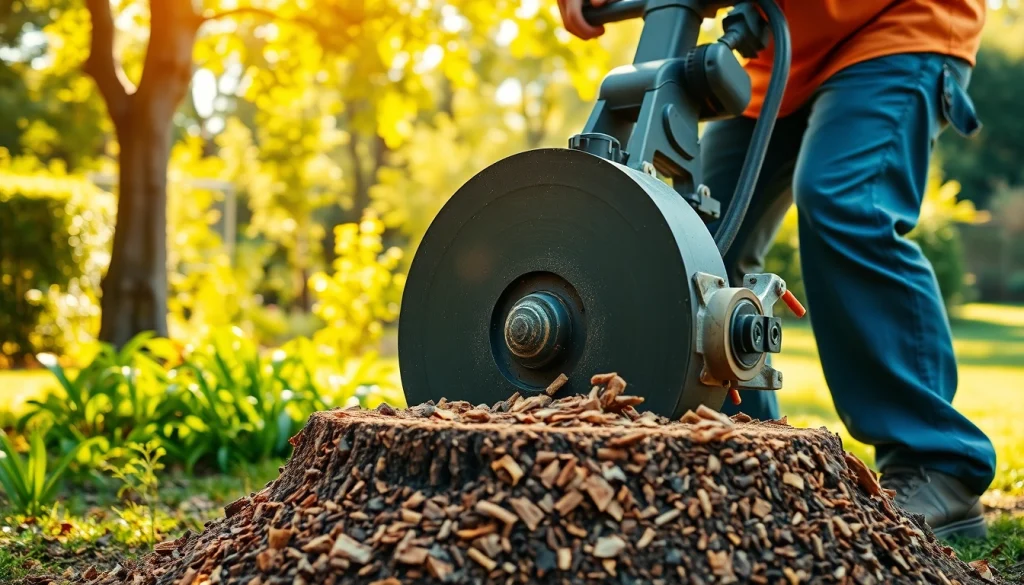Top 5 Essential Stump Grinding Service Tips for Optimal Tree Care

Understanding Stump Grinding: Basics and Benefits
What is Stump Grinding?
Stump grinding is a professional service designed to efficiently remove tree stumps left behind after trees have been felled. The process involves using specialized equipment, specifically a stump grinder, which is a powerful machine that chips away at the stump until it is ground down to below the surface of the surrounding soil. Unlike traditional stump removal, which involves digging out the entire root system, stump grinding focuses solely on the visible part of the stump, making it a less invasive option that minimizes disruption to the surrounding landscape.
Key Benefits of Stump Grinding Services
The advantages of hiring a stump grinding service go beyond simply clearing up your yard; they encompass environmental, aesthetic, and safety considerations. Here are some notable benefits:
- Enhanced Safety: Stumps can pose tripping hazards, especially in yards used for recreational activities. By grinding them down, you create a safer environment for children, pets, and visitors.
- Improved Aesthetic Appeal: Removing stumps not only clears up unsightly remnants of old trees, but also allows for better landscaping opportunities, enabling homeowners to redesign their yards to fit their preferences.
- Pest Prevention: Stumps can attract pests like termites, beetles, and fungi which can spread to surrounding trees and plants. Stump grinding eliminates this risk by removing the food source pests rely on.
- Efficient Use of Space: Once the stump is ground down, you gain use of that area for new plants, flowers, or even additional lawn space. This can be vital for homeowners looking to maximize their outdoor aesthetics.
When to Consider Stump Grinding
Stump grinding should be considered under various circumstances. If you have recently cut down a tree, it’s wise to grind the stump to prevent any issues associated with decay and pests. Additionally, property owners remodeling their landscapes or looking to install new features, such as patios or gardens, should prioritize stump grinding, as it clears the area for new designs. Waiting too long to remove a stump can lead to regrowth of the tree or damage from insects and fungi.
Choosing the Right Stump Grinding Service
Factors to Evaluate When Selecting a Service
Choosing the right stump grinding service is crucial for ensuring a successful job. Here are several factors you should consider:
- Experience and Reputation: Look for companies with a strong track record in stump grinding. It’s beneficial to see how long they have been in the business and their methods of operation.
- Certifications and Insurance: Verify that the service is properly licensed and insured. This protects you from any liability in case of accidents during the grinding process.
- Equipment Quality: Ask about the type and condition of the equipment used. Modern, well-maintained machines enhance efficiency and safety.
- Environmental Practices: Consider services that adhere to eco-friendly practices, supporting sustainability in tree care.
Comparing Prices and Services Available
When evaluating stump grinding services, it is essential to get quotes from multiple companies. While pricing can vary significantly based on location, service complexity, and stump size, it’s important not to choose solely based on cost. Look for services that offer transparent pricing and detailed descriptions of what their quotes include. This will help you avoid hidden fees or unexpected costs later on.
Reading Customer Reviews and Testimonials
Before making a final decision, take the time to research customer reviews and testimonials. Websites such as Google, Yelp, and local business directories can provide insights into the quality of service offered by stump grinding companies. Pay attention to recurring themes in reviews, such as professionalism, efficiency, and customer satisfaction. Additionally, you might consider asking friends or family for recommendations based on their experiences.
The Stump Grinding Process Explained
Initial Site Assessment and Preparation
Before any actual grinding occurs, a thorough assessment of the site is necessary. Stump grinding professionals will evaluate:
- Accessibility: Making sure the stump is accessible without obstruction, such as fences or nearby structures, is key for the grinding machinery.
- Location of Utilities: Checking for underground utilities is crucial to ensure that the stump grinding process does not disrupt any essential services.
- Surrounding Landscape: Understanding the landscaping and plant health around the stump is vital to avoid damage to surrounding flora.
Step-by-Step Guide to Stump Grinding
The actual stump grinding process involves several steps that ensure an effective and safe service:
- Site preparation: Professionals may clear any debris around the stump and mark any utility lines.
- Grounding: The stump grinder is positioned over the stump, and the operator grinds the stump, slowly bringing it down to approximately 4-6 inches below the ground level.
- Root Grinding: In some cases, roots may need to be ground as well to prevent regrowth.
- Debris Management: Professionals will collect and dispose of the ground-up debris, ensuring your yard remains tidy.
Post-Service Clean-up and Maintenance
Once the stump grinding is complete, the cleanup process begins. This typically includes:
- Filling the Hole: The hole left behind can be filled with soil or mulch, allowing for better lawn aesthetics and future planting opportunities.
- Department of Debris: Proper disposal of debris is essential, either through chipping, hauling away, or recycling processes.
- Maintenance Recommendations: The service may provide guidelines on how to care for your property after stump grinding, promoting the health and integrity of your landscape.
Common Stump Grinding Issues and Solutions
Addressing Safety Concerns During Stump Grinding
Safety is paramount during stump grinding. This includes not only the safety of the workers, but also the surrounding environment:
- Protective Gear: Stump grinding professionals should wear appropriate safety gear, including goggles, gloves, ear protection, and steel-toed boots to protect them from flying debris.
- Site Safety: The area should be cleared of onlookers and pets, as flying wood chips can create hazards.
- Handling Equipment: Only trained professionals should operate stump grinding equipment to ensure safety and efficiency.
Common Misconceptions About Stump Grinding Service
Several misconceptions about stump grinding can lead to hesitancy in hiring these services:
- It’s Too Expensive: While prices can vary, stump grinding can be considered a cost-effective option versus traditional stump removal, especially when factoring in time savings.
- Only for Big Stumps: Stump grinding is effective for various stump sizes, making it accessible for both large trees and smaller shrubs.
- Grinders Damage the Ground: Modern stump grinding techniques are designed to minimize damage to the surrounding soil and plants compared to digging out stumps.
How to Handle Difficult Stump Scenarios
At times, stump grinding can present unique challenges, such as:
- Large or Deep-Rooted Stumps: A professional service can utilize specialized equipment designed to handle larger stumps, ensuring effective grinding.
- Close Proximity to Structures: Professionals will take extra care when grinding stumps near homes or fences to avoid damage.
- Root Networks: Understanding the extent and depth of underground root systems can help professionals strategize effectively for complete grinding, including the removal of major roots.
Enhancing Your Landscape After Stump Grinding
Best Practices for Filling and Replanting
Once the stump has been ground, it’s important to address the remaining area:
- Selecting the Right Fill Material: Using quality soil or compost can provide nutrients for new planting and ensure a level surface.
- Choosing Plants Wisely: When considering replanting, opt for grass, shrubs, or flowers appropriate to your climate and soil type, ensuring they do not compete with existing plants.
Landscape Design Ideas Post-Stump Grinding
Stump grinding opens the door to a variety of landscape design opportunities:
- Garden Beds: Consider creating a flower or vegetable bed in the former stump location, enhancing beauty and functionality.
- Outdoor Structures: Use the cleared area for patios, fire pits, or seating areas, transforming the land into a social space.
Maintaining Your Garden After Service
Once your landscape has been redesigned, proper maintenance is crucial. Here are key tips to keep your garden thriving:
- Watering Schedule: Ensure that new plants receive adequate water without over-saturating the ground.
- Weed Control: Implementing mulch or ground covers can prevent weeds from overwhelming newly planted areas.
- Regular Assessment: Monitor plant health and soil conditions regularly to adjust care techniques as needed.







